
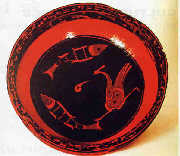 |
| Painted fish-pattern lacquer vessel, Qin Dynasty (221-206 BC) |
Traditional Chinese lacquer art applies natural lacquer liquid from lacquer trees. China is abundant in lacquer resources. Lacquer trees in Mainland China are distributed in some
550 counties in 23 provinces.
Starting from red lacquer wood bowls and painted potteries in the Neolithic age, Chinese lacquer art enjoyed rapid development in the Warring Period (770-256BC) and the Han Dynasty (206BC-220AD), thanks to the upgraded productivity of the time.
According to historical documents, lacquer trees were widely planted during the Warring Period (770-256BC). Famous philosopher Zhuang Zi, founder of Daoism, worked as an official overseeing lacquer plantations for some time. At that time, lacquer was regarded as important as daily necessities such as linen, mulberry, fish and salt, and lacquer craftsmanship were remarkably raised. There were wood, bamboo and linen lacquer wares. Linen lacquerwork, not restrained from material sources, can be made in any shape. The improved craftsmanship gave rise to a multitude of lacquerwork varieties.
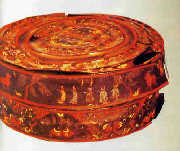 |
|
Red lacquer bowl |
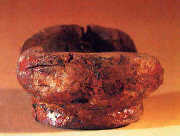 |
| Painted lacquer case, late Warring Period (476-256 BC) |
During the ensuing Jin (265-420AD) and Northern and Southern Dynasties (420-589AD), thanks to the introduction and widespread of Buddhism in China, lacquer art began to be applied to Buddha sculptures. One of the important excavations of this time is a lacquer wood screen unearthed in a tomb in Datong, Shanxi Province. The screen, carved with black inscriptions and painted in red lacquer, has lacquer paintings on it, which is based on "Legends of Heroic Women" of the Han Dynasty (206BC-220AD). This lacquerwork is a masterpiece both for its painting and calligraphy.
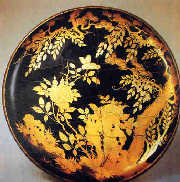 |
| Gilded black lacquer plate, Qing Dynasty (1644-1911 ) |
In the Ming Dynasty, a famous craftsman named Huang Cheng, based on experiences of his own and previous craftsmen, wrote the first book on lacquer art. The book was later annotated by another famous lacquer craftsman, which make it China's only completer theoretic works on lacquer art.
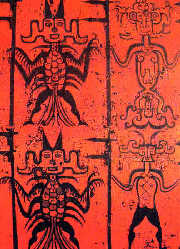 |
| Patterns on the inside of a painted coffin, early Warring States Period (476-225BC) |
Modern lacquer painting, as an independent painting genre, has developed for some 40 years and has been recognized by public. Its success should be attributed to richness of traditional lacquer art and techniques. Modern lacquer paintings have been displayed in each national fine arts exhibition. And lacquer painting courses are now offered in several fine arts colleges, including the fine arts school ofTsinghua University, Nanjing Arts Institute and the crafts and design school of Fuzhou University.
Based on traditional lacquer techniques, modern lacquer artists have explored different qualities of lacquer and created many new techniques. Lacquer is not simply a decorative material. It is now used to stick egg shells and mental pieces. Lacquer is also used as a cohesive to make colored paint together with mineral pigment. The flowing quality of lacquer enables artists to use it at their will in their creations. When it is dried, lacquer can be grinded by charred wood or abrasive paper, which make the modern lacquer art possible.
Since the 1980s, Chinese lacquer art has been showcased in many countries including Japan, South Korea, Vietnam and former Soviet Union and has drawn extensive interest of the international art circle.

Presented by Chinadaily.com.cn Registration Number: 10023870-7
Copyright © Ministry of Culture, P.R.China. All rights reserved